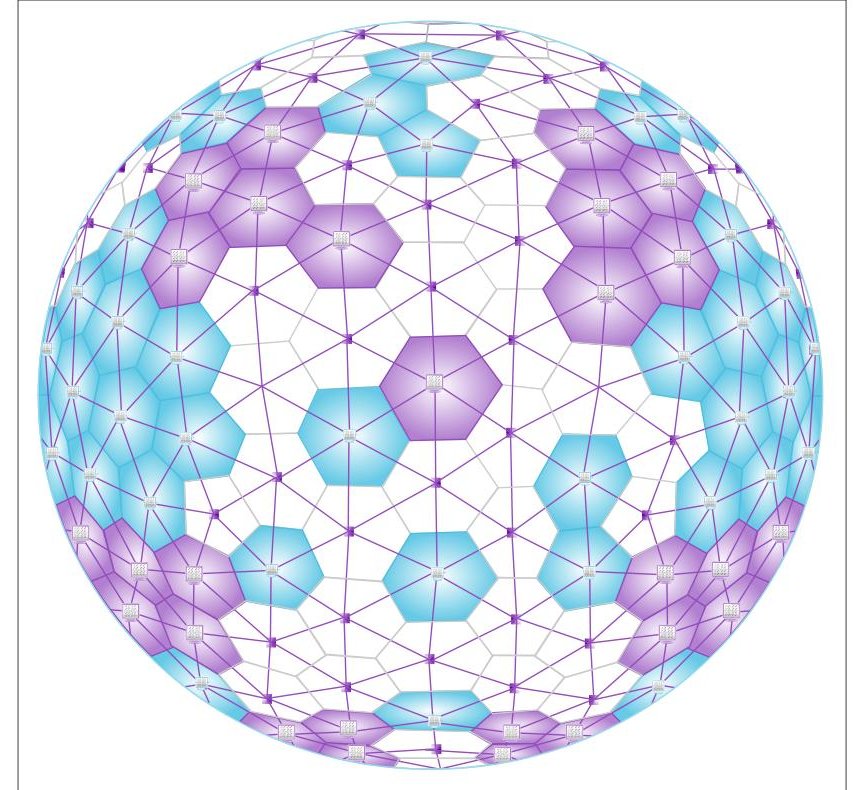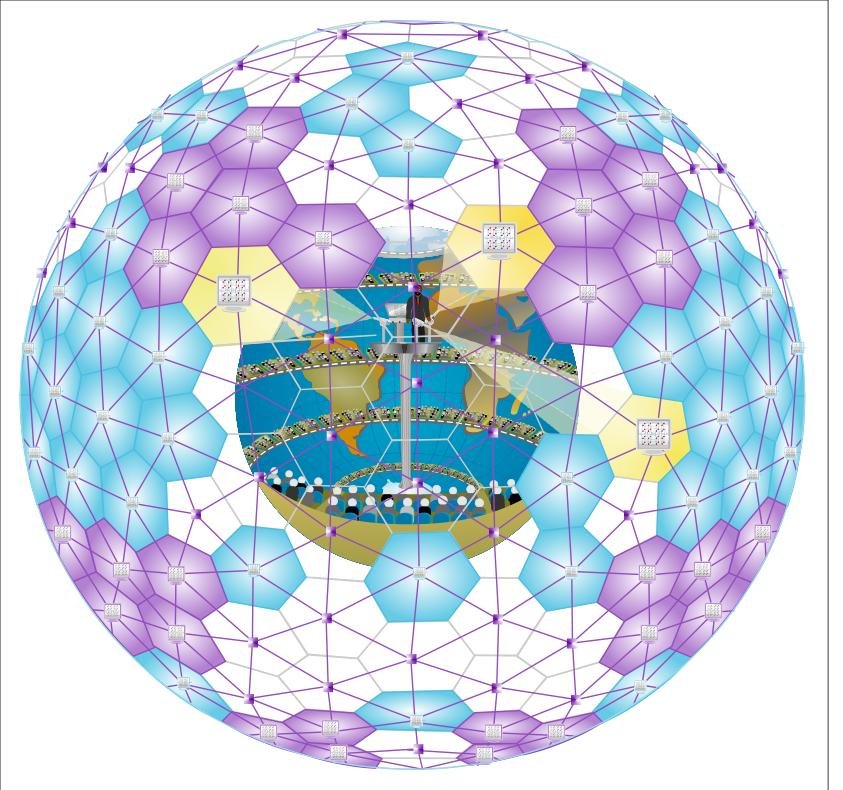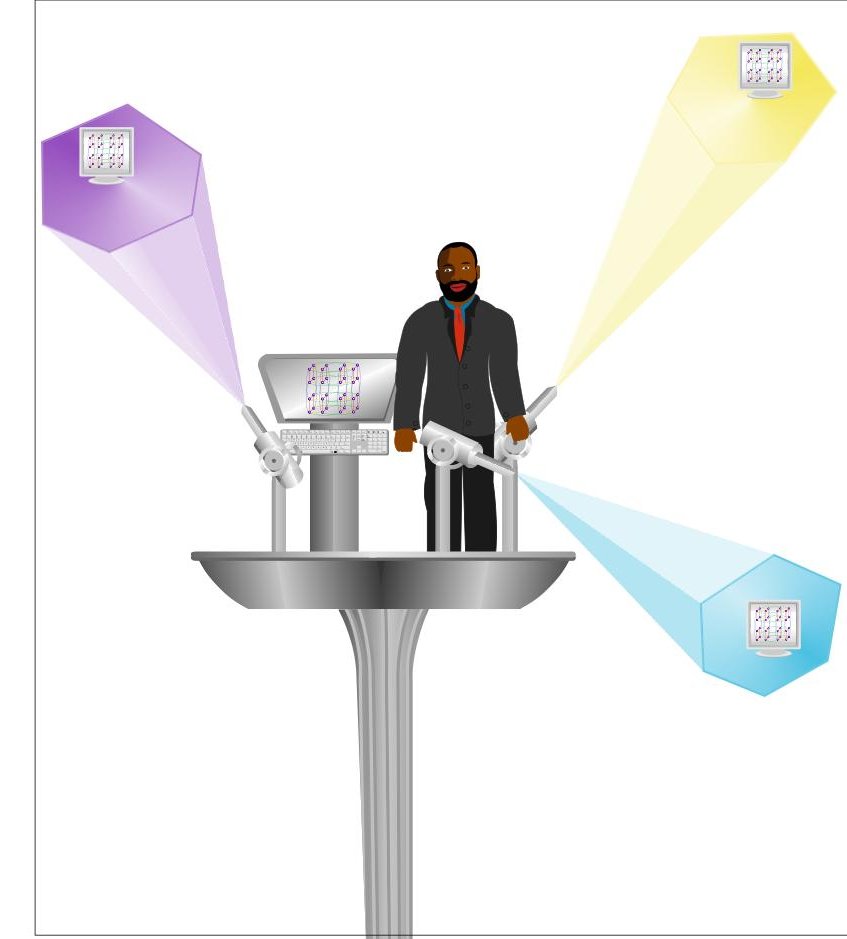|
|

Global Brain as a Super-Brain

Perhaps Bob Dylan is right when he sings, "You don't need a weatherman to tell which way the wind blows."
But you certainly need considerable expertise to know which way it will be blowin'
tomorrow or a few days hence, how strong its blast will be, where it is likely to turn
and what damage it is capable of doing. Throughout history, people have attempted to predict the weather ---
usually with little success. In the Middle Ages it was believed that the weather could be forecast by studying the motions of the stars, the behavior of wildlife or the condition of certain plants. Today, some people still rely on the Farmer's Almanac, which uses a 200-year-old "secret formula" and "calculations based on solar activity." Meteorologist Lewis Frye Richardson understood the
computaton-intensiveness of weather forecasting.

Artist's illustration of Emeagwali's vision of an Earth-sized HyperBall computing theatre for weather forecasting, which in today's parlance is called an "Internet." Emeagwali's vision was, in turn, inspired by the 1922 vision of Lewis F. Richardson, who believed that 64,000 human clerks would be
needed to accurately forecast the weather.



Emeagwali's illustration of how to design his hyperball computer
for weather forecasting. Emeagwali is the first scientist to invent a
computer network that can accomplish what Lewis Richardson envisioned. He also
predicted that cyberspace will eventually become one hyperball computer with billions of processing nodes.

Inspired by the HyperBall international network that
he invented in 1975, Emeagwali used a hypercube computer
to solve the world's largest
mathematical equations (128 million locations in 1989)
for weather forecasting.
After receiving international recognition in 1989, his earlier work
on the HyperBall which was previously dismissed as "nonsense" was re-interpreted as "ahead of its
time."
He is regarded as "one of the fathers of the
Internet."
The following passage from Richardson's Weather Prediction by Numerical Process, published in 1922, illustrates his farsightedness. It is a description of a huge amphitheater filled with "64,000 computers to race the weather of the whole globe." (In Richardson's day, "computer" still referred not to a machine but to an individual using an abacus, logarithmic table or slide rule. Here is Richardson's vision of the assemblage of computers needed to predict the weather mathematically: "Imagine a large hall like a theater, except that the circles and galleries go right round through the space usually
occupied by the stage. The walls of this chamber are painted to form a map of the globe.
"Myriad computers are at work upon the weather of the part of the map where each sits, but each computer attends only to one equation or part of an equation.
The work of each region is coordinated by an official of higher rank.
Numerous little 'night signs' display the instantaneous values so that
neighboring computers can read them. Each number is thus displayed in three
adjacent zones so as to maintain communication to North and South of the map.
"From the floor of the pit a tall pillar rises to half the height of the wall. It carries a large
pulpit on its top. In this sits the man in charge of the whole theater; he is surrounded by several assistants and
messengers. One of his duties is to maintain a uniform speed of progress in all parts of the globe. In this respect he is like the
conductor of an orchestra in which the instruments are slide rules and calculating machines."
Several features of Richardson's giant computer with human components correspond to the hyperball computer, invented by the writer.
The similarities include the following:
- The 64,000 human computers of Richardson's vision are analogous to the thousands of processors of the hyperball computer.
- According to Richardson, "The work of each region is coordinated by an official of higher rank, ... Four senior clerks in the central pulpit are collecting the future weather as fast as it is being computed, and dispatching it by pneumatic carrier to a quiet room. There it will be coded and telephoned to the radio transmitting station." Richardson's senior clerks will be analogous to the control processor or front-end of the hyperball computer.
- The slide rules and calculating machines that increased computational speed in Richardson's era will be analogous to the "floating-point accelerators" of hyperball computers.
- The "myriad computers at work upon the weather of the part of the map where each sits," can be described as mapping and load distribution in the hyperball.
- Richardson's concept that "each computer attends only to one equation or part of an equation," will be the equivalent of
local computation within the hyperball.
- In Richardson's Computing Theatre "... Each number is thus displayed in three adjacent zones so as to maintain communication to North and South on the map." The latter is analogous to our internode communication.
These are only a few examples of the parallels that could be drawn between Richardson's computing theatre and the hyperball computer. Richardson's vision was bold and wonderful because he understood both that
weather forecasting is computation-intensive and therefore will require 64,000 human
weather forecasters. Richardson viewed his ideas as science fiction and wrote the above
piece for entertainment purposes. On the contrary, I am taking the concept of the computing theatre very serious and used
it as inspiration to design the hyperball computer.
The hyperball is a parallel computer that replicates the spherical structure of problems defined over a
globe, such as the Earth, planets, heavenly or celestial bodies.
The hypothetical computing theatre was imagined to have 64,000
human computers located around the spherical-structured Earth.
That form is massive parallelism --- that is, the massively numerous
calculations are also subject to the same mathematical description operating in parallel throughout the
phenomenon under investigation. What Richardson did not foresee, however, is that accurate weather
forecasting, especially a long-term forecast
of global warming, would require about a billion billion calculations. In fact,
it would have taken his 64,000 human computers more than 1,000 years just to forecast
the next day's weather! Each processor in the hyperball computer has far greater computing power than
one human computing clerk. Collectively, the thousands of processors of the hyperball
computer can solve the equations that govern weather forecasting at a rate of over one
trillion calculations per second. Richardson is greatly admired for his unique vision and early
contributions to numerical analysis and is widely regarded as the father of numerical weather prediction. What he did not envision was
a massively parallel hyperball computer. For the first time, I am proposing this hyperball
technology as a practical means of solving complex real-world scientific problems. Richardson was obviously unaware that the most accurate forecasts would require
a billion billion calculations. This many calculations would have taken his
64,000 human computers over 1000 years just to forecast the next day's weather! Off course, there are some differences between Richardson's Computing Hall and the modern hyperball computer. Each hyperball processor has far greater computing power than each human computer. Collectively, the thousands of processors of the hyperball computer can solve the governing equations used in weather forecasting at over one trillion calculations per second, at a very small fraction of the cost and with significantly greater reliability than Richardson's Computing Hall. The analogy between Richardson's vision and the contemporary use of computers for weather forecasting is historically interesting. However, even more important is the recognition that massively parallel computing can lead to more accurate weather forecasts which will provide huge social and economic benefits. Accordingly, the United States included weather forecasting as one of the twenty national Grand Challenges in science and engineering. The classification of weather forecasting
as a scientific "Grand Challenge" would have delighted Richardson, who was dismissed as an idle dreamer by
his contemporaries.
Today, eighty years after Richardson wrote his mathematical fantasy, the writer has discovered that the
hyperball computer is the only technology that will enable us to fulfill Richardson's dream.
NOTE: The preceding article was published in the
February 1991 issue of MICHIGAN TODAY, a quarterly publication
that describes the most innovative research conducted at the
University of Michigan in Ann Arbor. The later issue
focused on Emeagwali's research
and was mailed to
the university's 400,000 alumni. Some of the original
illustrations and photographs were not available and, for this reason,
we have added a few images for your benefit.
CAPTIONS OF MISSING PHOTOS
- Quadrillions of calculations are needed to model Earth's climate. A conventional
supercomputer (diagram #1) tries to use one processor to perform the quadrillions of
calculations. It's very powerful, but not powerful or fast enough to complete the
calculations in time to yield a useful forecast of approaching weather.
- The natural laws governing Earth's weather--and the mathematical equations derived
from those laws--operate at all locations in our atmosphere, and in the same way
(Diagram #2). Therefore, the quadrillions of calculations required to solve weather
equations are distributed evenly throughout the globe, whether the climatic conditon is
a blizzard in Boise, a thunderstorm in Oslo, torrential rains in Bangladesh or bright sun
over Harare. When a natural law applies to all locations in the same way, the problem
is inherently massively parallel.
- The architecture of a massively parallel computer is designed to match the
computer with the problem. To perform calculations in weather prediction, a
massively parallel computer assign different locations around the globe to different
processors inside the computer (diagram #3). Today, the most powerful massively parallel
computer has 64,000 processors. A massively parallel computer with a million processor is under construction.
- There's a supercomputing race between --- The Chickens and the Ox.
- The march of technology is towards oodles of calculations in almost no time at all.
- Climate Modeling: Using a Connection Machine supercomputer, scientists at Los
Alamos National
Labs are modeling Earth's climate. They stretch a mesh of 500,000 tetrahedrons over a
model of the globe, then compute changes to the weather in each cell. Every tetrahedron
spans an area of about 20 miles.
To gain accuracy, the mesh actually stretches out over areas of calm weather,
but twists and bunches up
around local disturbances like hurricanes. Red areas indicate high kinetic activity;
land-masses are yellow; low and lowest areas of activity are whitish and purple,
respectively. The technique was first developed to model explosions.
The advantage of massively parallel computers like the Connection Machine is that after one processor is programmed to
calculate such weather variables as pressure, temperature, humidity and wind-speed for its
tetrahedron, the computer does the rest, directing the other processors to calculate the variables
at the remaining half-million locations at discrete intervals.
In The Mathematics of Chaos, Ian Stewart compares numerical weather prediction to a three-dimensional
chess game. The tetrahedral grids form the board, the numerical values assigned to weather variables are the pieces,
and tomorrow's weather corresponds to a position of the game. The governing rules are the equations of motion of the atmosphere.
-
Simulation of seismic waves propagating through a model containing a
salt dome. A salt dome is an arching formation in sedimentary rock that has a mass
of rock salt as its core.
- The 1922 dream of Lewis F.
Richardson: 64,000 human computers to calculate the variables required to predict the
weather numerically. He foresaw that mathematical forecasting was computation-intensive,
but didn't realize it would have taken his calculating army 1,000 years to predict the next
day's weather!
|








